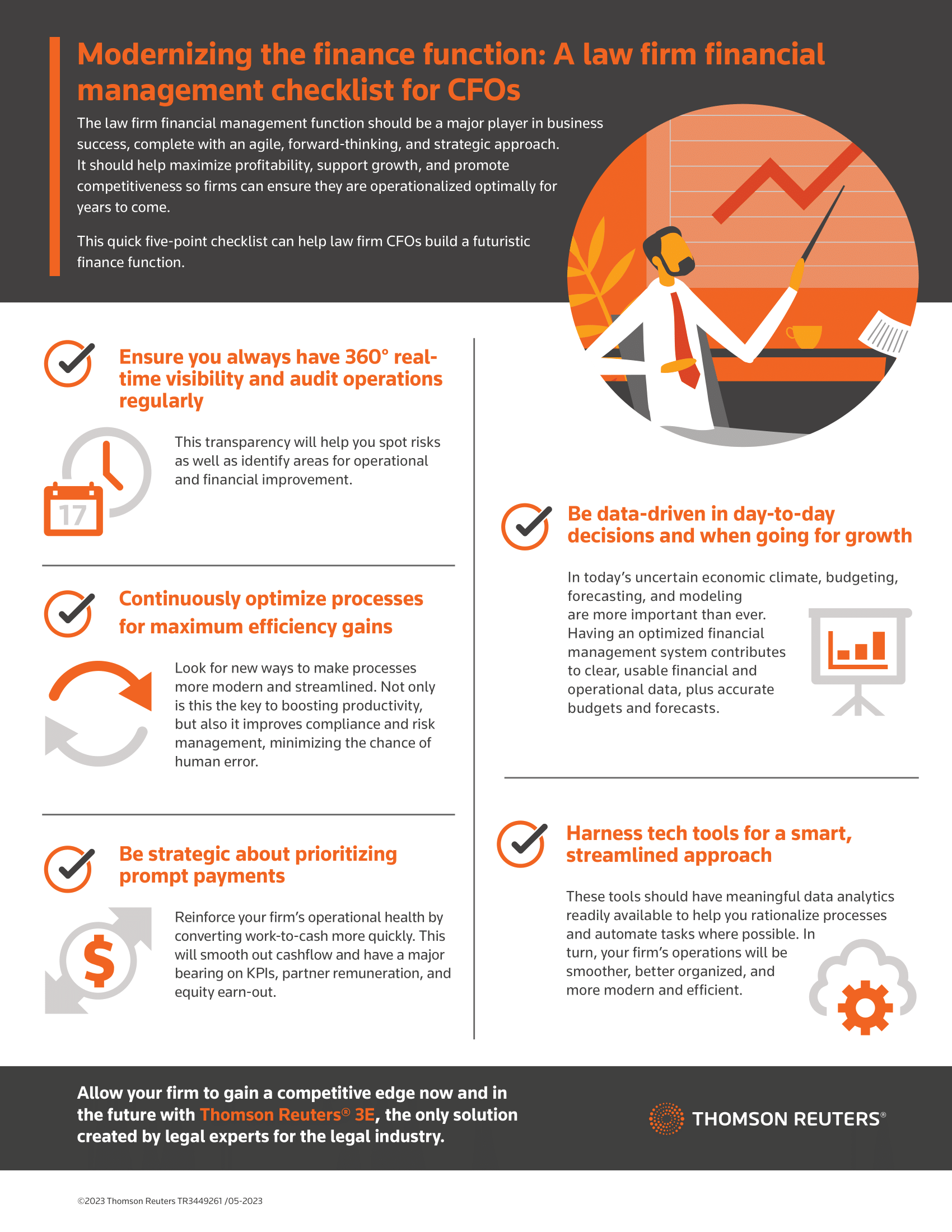A law firm financial management checklist for CFOs
The law firm financial management function today goes far beyond playing a supporting role: it should be a major player in business success. It needs to take an agile, forward-thinking, strategic approach to financial management if it is to help maximize profitability, support growth and promote competitiveness. That requires strong internal relationships and a robust financial management infrastructure rooted in smart technology, so firms can ensure they are operationalized optimally for years to come.
Pausing periodically to work out what you’re doing well and what needs to change is vital to make sure that financial management systems and firm-wide processes are fit-for-purpose, so that risks can be mitigated, opportunities are seized, and goals can be met. Though change can be challenging, it’s not something that law firm leaders can afford to shrink from or ignore.
To help guide thinking around these issues, here’s a five-point financial management checklist for CFOs to build a futuristic finance function:
1. Continuously analyze and regularly audit operational performance.
Know exactly where you are at all times in real time — both in terms of how you are performing and how you are getting there. Having up-to-date data analytics readily available at your fingertips in a clear and meaningful format means that you’re less likely to get caught out by nasty surprises, helping to spot risks before they become problematic and make reporting easier.
This transparency also enables you to identify areas for operational and financial improvement, prioritize actions that need to be taken, and plan ahead with confidence.
2. Dial up efficiency savings.
Remain on alert for new ways to make processes more modern and streamlined; for example, by automating manual tasks, reducing the number of touch points necessary to achieve outcomes, and eliminating other causes of friction that slow things down. This is key to boosting productivity and profitability by empowering your team as well as lawyers and other support staff to do more in less time.
This should have the added benefit of increasing job satisfaction and boosting staff motivation as well as keeping clients happier. It also improves compliance and risk management by standardizing processes and minimizing the chances of human error.
3. Zoom in on accelerating payments.
Strengthen your cash position and shore up working capital by being strategic about making sure you get paid on time, every time. Ask yourself, your team, and the wider firm probing questions about how to achieve this.
- Where could you improve WIP management?
- What levers can you pull to speed up time-to-pay?
- What checks and balances can you deploy to eliminate the risk of bills being contested or written-off?
Not only does converting work-to-cash more quickly smooth out cashflow, it also has a major bearing on KPIs, partner remuneration, and equity earn-out. Ultimately, this is about reinforcing the firm’s operational health.
4. Encourage data-driven decision making.
Budgeting, forecasting, and modeling are harder yet more important than ever in today’s uncertain economic climate. So it’s crucial to be able to adjust actuals and assumptions quickly and easily so that you’ve always got a reliable picture of both your current circumstances and the outlook ahead so you can spot opportunities as well as threats. That’s essential for day-to-day decisions and when going for growth. Successful growth — whether that’s driving revenue, expanding into new areas, or undertaking a merger or acquisition — will be predicated on having clear, usable financial and operational data plus accurate budgets and forecasts, both of which are underpinned by optimized systems.
5. Stay ahead of the curve with smart tech tools.
All of the above rely on having meaningful data analytics readily available, rationalizing processes and automating tasks where possible in order to make operations smoother, better organized, and more modern and efficient. That means using smart tech tools to stay ahead of the curve and deliver continuous process improvements — and deeper, clearer insights all at the same time. It’s like having a superpower that enables you to speed things up and do things better, in a way that’s fit-for-purpose now and ensures you are ready for whatever the future holds.
Start now to deliver the finance function of the future
Delivering the finance function of the future needs to start now. It should be an evolving process, where you aim to stay at the forefront of best practice and innovation. It should harness the power of data to provide 360° visibility at all times to inform decisions, and be rooted in sophisticated yet easy-to-use technologies that both modernize and enhance your operations.
Solutions like 3E have been built with all these issues in mind, leveraging decades of experience of working with thousands of law firms to deliver the productivity, security and confidence your firm needs from a practice and financial management solution.
Learn more about why it’s so important to be a “data-driven CFO” and how modern tech tools are helping to shape and empower the evolution of financial leadership in the legal sector today by reading our white paper.










